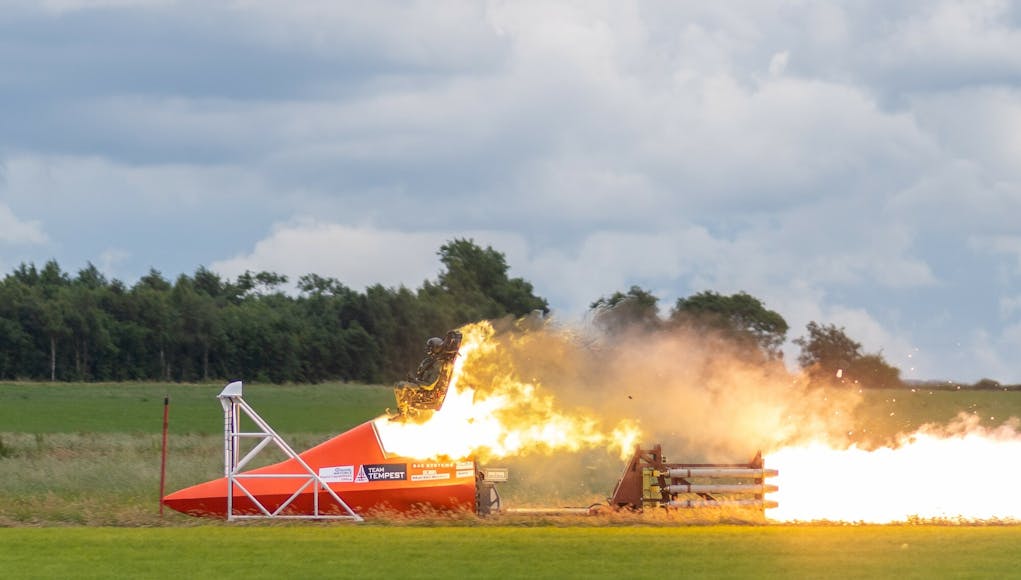As part of the ongoing development of the UK’s next-generation supersonic stealth combat aircraft, Tempest, engineers have recently conducted high-speed ejection seat trials.
These trials are critical to ensuring the safety and reliability of the aircraft’s crew escape systems.
Working closely with Martin Baker, a UK specialist in crew escape technology, a team of engineers from BAE Systems led the ejection seat trials. The tests employed a rocket-propelled sled that achieved speeds in excess of 500mph.
Testing Britain’s New Fighter Jet! Get a glimpse into the rigorous ejection seat trials for Tempest, 🇬🇧 Britain's new state-of-the-art fighter jet. Ensuring pilot safety is paramount and it results in some cool videos! 🎥 #NextGenFighter pic.twitter.com/EvSkBqeeJl
— UK Defence Journal (@UKDefJournal) June 13, 2023
This collaboration is part of the broader efforts by experts from BAE Systems, Rolls-Royce, Leonardo UK, MBDA, and the Ministry of Defence (MOD) in conjunction with various British small and medium-sized enterprises.
The ejection seat trials are part of the Flying Technology Demonstrator programme, which is aimed at developing Tempest, the UK’s next-generation combat aircraft. The programme was first announced by the UK Government in July 2022 and is expected to see the aircraft take flight within the next four years.
Not only do these tests play a vital role in the safety aspects of the aircraft, but they also provide an opportunity for experienced engineers to work alongside junior team members, thereby passing on vital skills that can be harnessed for future developments of Tempest.
Neil Strang, Tempest Programme Director at BAE Systems, emphasised the significance of this phase in the programme. He said, “It’s now 40 years since our people led the demonstrator aircraft programme which gave birth to Typhoon and the work we’re doing today is another once-in-a-generation opportunity to write the next chapter in aviation history.” He also highlighted the collaborative nature of the programme, with “young apprentices and graduates working alongside some of our most experienced engineers.”
Richard Berthon, Director Future Combat Air for the MOD, also underscored the importance of the Flying Demonstrator programme, calling it a “remarkable effort to design and build a supersonic stealth jet that will prove integration and develop our national skills, while providing data and learning in support of Tempest entering service by 2035.“














it’s nice to see real world evidence that the program exists
Maybe we also get a sneak peek at what the nose looks like?
There is real urgency now, in defence circles, to get stuff done.
The old sense of ‘why are we here’ – ‘what us this really for’ is long gone by all accounts.
No one else is testing ejection seats on their 6 Gen systems years before they are even completing designs. This smacks as a gimmick to me, make it looks like we are doing something because we have not got funds to do anything else.
I’m sure the UK will be developing a next Gen ejector seat as part of the program and its a big export success for the UK.
If the schedule is 4 years to demonstrator test flight then it is about right
“ I’m sure the UK will be developing a next Gen ejector seat as part of the program and its a big export success for the UK.”
Martin Baker are a great export success for UK?
Probably because Martin Baker is doing much of it for them perhaps.
No one else has shown anything real and hard that is 6th gen.
So this is a first and a great sign.
SB it looks like almost identical to the F35 nosed sled that Martin Baker had with a slightly raised fairing to the canopy. Although the early graphics suggest that the nose maybe similar to the F35 anyway🤷🏻♂️ So who knows
Its the rocket sled from the Hawk Advanced Trainer, theyve decided on a combination of the canopy ejection system from the Hawk and the same model Mk16A ejector seat as the Eurofighter and so are testing them in combination.
I suspect as is the case with cars, the parameters from wind tunnel tests give you an optimum shape. Add in Stealth technology, fly by wire, and the generic shape is there already. I cannot see anything radical coming out of this. Let’s hope I am wrong. There is one version I would like to see explored, at this early stage. Pilotless.
Assume that took place at Chalgrove?
We don’t want to go down the F35B route again…
Lockheed Martin are looking forward to the day they can concentrate on offering an advanced block 5 F35A derivative and drop the B and C…
All things to all men, is a nice tag line, but balloons technical complexity to bursting point!
The only reason they didn’t pull the plug on F35, is that the programme was of immense strategic importance and basically too big to fail….
When Tempest enters service ‘by 2035’, what will the RAF be forced to give up?
I recall they were not allowed to retain three fast jet types in service not so long ago, so binned the Harrier and retained Tornado and Typhoon.
Tempest…. That is an absolute joke.
You have to say a bit more than that to be taken seriously. In what way is Tempest, an absolute joke?
Delete tempest insert Esteban! 👜
If the next gen of fighter involves human pilots then they are at least two generations behind everyone else